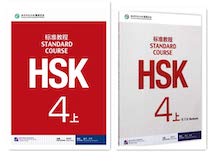How to Pass HSK 4: Efficient Strategies for Mastering the Exam
Learn Chinese in China or on Zoom and gain fluency in Chinese!
Join CLI and learn Chinese with your personal team of Mandarin teachers online or in person at the CLI Center in Guilin, China.

It's Time to Pass HSK 4!
Are you planning your strategy to pass HSK 4? Perhaps you need an HSK 4 score to demonstrate your Chinese level to prospective employers, add points to your Chinese work visa application, or gain entry into an academic program. Maybe you’re just hoping to score some bragging rights.
Whatever your reasons, deciding to take the exam is only the first step. Next comes the hard part: test prep.
Even students with strong language skills can have trouble passing unfamiliar exams. No matter how confident you feel about your Chinese abilities, you should still spend time familiarizing yourself with the exam’s structure and content through efficient, targeted practice.
STEP 1: Select your HSK 4 test prep study materials
Before diving into the details of how to set up a strategic HSK 4 study routine, you’ll need to arrange effective study materials. Simulated Tests of the New Chinese Proficiency Test HSK (HSK Level 4) is a great resource. It comes with CDs for listening practice and includes a collection of practice tests and corresponding answer keys. Systematically working your way through the practice tests in this book is the best way to prepare yourself to pass the real exam.
When studying for the exam, we highly recommend the HSK 4 books available at the above links. Once you have your study materials in hand, you'll be ready to work your way toward HSK 4 mastery.


STEP 2: Understand what you’ll be tested on
Once you’ve arranged your study guide, review it to familiarize yourself with the basic content and structure of the HSK 4. You’ll see that there are 3 sections: listening (30 minutes), reading (40 minutes) and writing (25 minutes). Although the highest possible score is 300, only 180 is required to pass HSK 4. Note that there is no minimum required score for each section. The exam lasts 105 minutes and covers 1,200 vocabulary words.
The writing section of the traditional paper-based HSK 4 includes five questions that involve handwriting a sentence in Chinese based on a given picture and word. Consider using an app like Skritter to practice writing characters. If your Chinese handwriting still needs work, consider taking the exam online since the online version of the HSK 4 doesn’t require you to handwrite Chinese characters (you’ll need to type them instead). If you choose to take the online version, make sure to do some online HSK practice tests first.


STEP 3: Set a clear, consistent study schedule and stick to it
Next, you’ll need to set (and stick to) a study schedule that allows you to work through a large number of practice tests in a systematic and consistent way. Most students will need at least one month of daily practice, although the total time needed can vary based on level. Set aside one full hour for daily study and help yourself stay committed by practicing at the same time each day. To systematically build speed and endurance, you’ll need to create a practice routine that increases in difficulty and intensity as you get closer to test day. Here’s how:
Week One
During your first week, familiarize yourself with the HSK exam by completing one untimed practice test section per day (it’s best to start with reading or listening since these sections are the longest and contain the most new words). Once you’ve finished, check your answers and clearly mark the ones you got wrong. Then, carefully review each incorrect answer, making sure you thoroughly understand not only the questions and answers but also why you got them wrong. While reviewing your incorrect answers, you should also look up and make flashcards for any unknown words (see STEP 4).
Week Two and After
Starting from your second week, improve your test-taking speed by completing one timed listening, reading or writing section every other day. You probably won’t be able to finish within the allotted time at first, but your speed will increase with practice. On days when you aren’t doing timed practice, check the previous day’s answers and make and review vocabulary flashcards. Continue doing this until one week before your test date.
The Week Before Test Day
In the week before the test, set aside several long blocks of uninterrupted time to complete 2-3 full-length, timed exams, each within a single sitting. Make sure to check and review your answers after each practice test! Doing full-length tests will help you build stamina and endurance in preparation for the real exam.


STEP 4: Make flashcards targeting your personal weaknesses
After learning that the HSK 4 covers a fixed set of 1,200 words, you may be tempted to start memorizing HSK 4 vocabulary lists. Don’t do it! Memorizing long, unfocused lists is demoralizing and inefficient. Instead, make a personalized list. This will help you pass HSK 4.
Resist the urge to look up every new word you see while working through practice tests. Instead, guess word meanings from context (after all, you won’t be able to look words up on test day). Once you’ve finished a section, you should focus on looking up unknown words that appear in questions you got wrong using a Chinese dictionary app like Pleco. Then, create electronic or paper flashcards to help remember these words.
You should also make flashcards for unknown words you notice appearing frequently during practice tests. In the end, you’ll have a stack of flashcards targeting the words most likely to trip you up on test day. Make sure to quiz yourself using these flashcards during your daily study sessions.
STEP 5: Improve your overall Chinese level
While there’s absolutely no substitute for consistent, test-focused preparation, if your test date is still a few months away, consider spending some time improving your overall Chinese level. Try watching ChinesePod videos, which provide an entertaining way to improve your listening while expanding your vocabulary. You can also listen to Chinese radio broadcasts using an app like 蜻蜓 or watch Chinese TV shows (without subtitles) such as the Friends-inspired sitcom 爱情公寓 or 神雕侠侣, a martial arts period drama based on a popular series of Wuxia novels. You may also want to brush up on your basic Chinese grammar.
Have fun using these resources in your free time, but don’t let them encroach on your daily hour of efficient, targeted and exam-focused practice. With a little persistence and dedication, you’ll pass HSK 4 without blinking an eye!


Vocabulary Related to Test-Taking
| Hànzì | pīnyīn | English |
|---|---|---|
| 考试 | kǎoshì | exam |
| 汉语水平考试 | Hànyǔ Shuĭpíng Kǎoshì | HSK |
| 考场 | kǎochǎng | exam venue |
| 考点 | kǎodiǎn | test site |
| 考生 | kǎoshēng | examinee |
| 考官 | kǎoguān | examiner |
| 笔试 | bĭshì | written exam |
| 口试 | kǒushì | oral exam |
| 备考 | bèikǎo | prepare for an exam |
| 背 | bèi | memorize |
| 单词 | dāncí | individual word |
| 词汇 | cíhuì | vocabulary |
| 刷提 | shuātí | do practice exam problems |
| 作弊 | zuòbì | to cheat |
| 通过 | tōngguò | to pass (a test) |
| 没通过 | méitōngguò | to fail (a test) |
| 报名 | bàomíng | sign up |
| 模拟考试 | mónĭ kǎoshì | practice test |
| 在线模考 | zàixiàn mókǎo | online practice test |
| 试卷 | shìjuàn | test paper |









